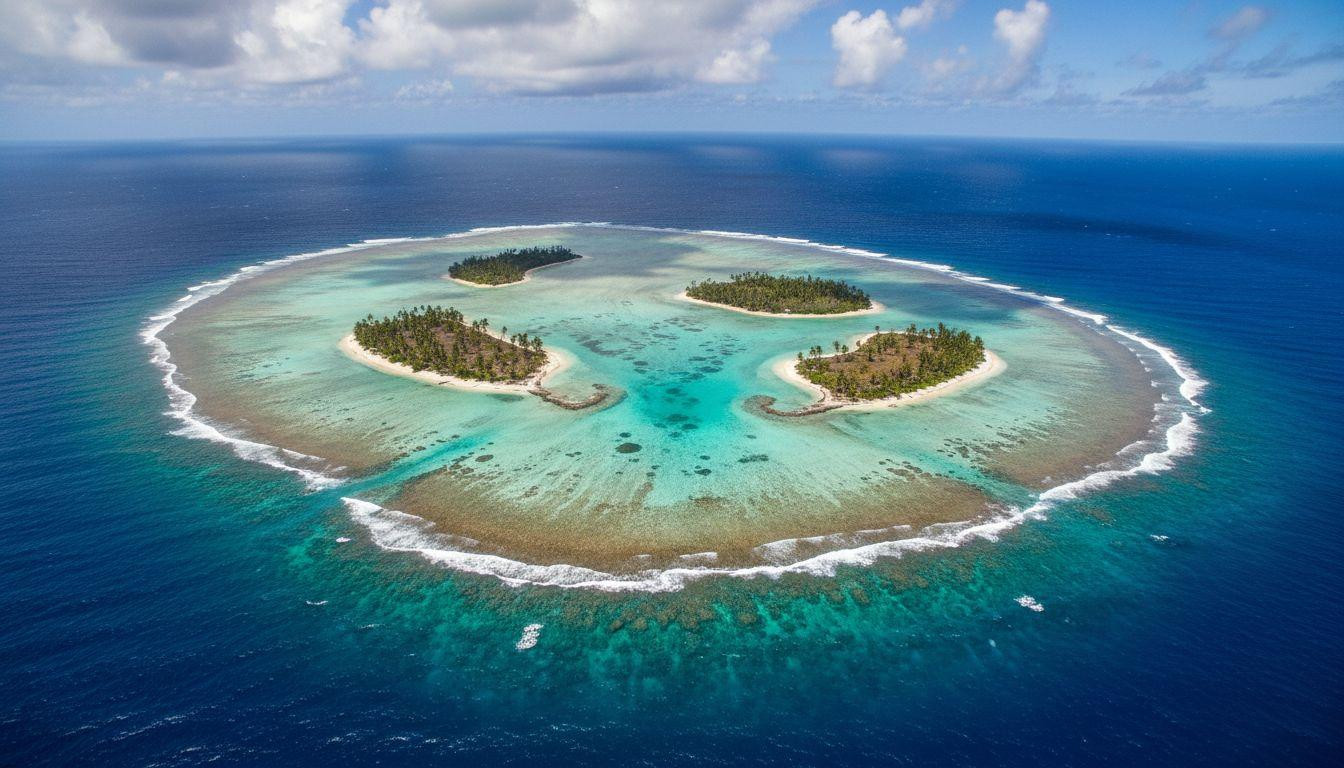When Caribbean postcards promise turquoise water and coral reefs, most point to the Maldives or Bora Bora. Six coral-fringed islands exist where permit systems and remote access protect pristine ecosystems from mass tourism. These destinations reward travelers who plan ahead and respect conservation boundaries with authentic experiences impossible at mainstream resorts.
Aldabra Atoll: where giant tortoises outnumber tourists 152,000 to 100
This UNESCO World Heritage site sits 1,100 miles southwest of Mahé in the Seychelles. No airports exist here, no hotels, no gift shops. The Seychelles Islands Foundation requires special permits and limits visitors to 100 per day.
Expedition cruises operate from May-October only. Aqua Expeditions charges $18,500 for 10 days, including all permits and biosecurity inspections. Alternative operators like Zegrahm charge $22,800 for 12-day trips.
Giant Aldabra tortoises roam freely across fossilized coral moonscapes. The flightless Aldabra rail, the Indian Ocean’s last flightless bird, calls at dawn with distinctive “kroo-kroo” sounds. Visitors walk on crunchy coral sand that stays cool even at midday, unlike the fine silica of typical tropical beaches.
Tubbataha Reefs: liveaboard diving in the Philippines’ protected waters
This UNESCO marine park floats 150 miles offshore from Palawan. The Tubbataha Management Office allows access only from March-June via liveaboard dive boats. November visitors must plan for the following year’s season.
Pristine coral walls with 68% live coverage
Coral coverage exceeds 68%, compared to the Great Barrier Reef’s 32% average. Dive operators like Atlantis charge $420 per day for three dives. Advanced certification opens wall dives beyond 100 feet.
Hammerhead sharks patrol deep blue waters. Napoleon wrasse, some over 6 feet long, approach curious divers. Manta rays glide overhead during seasonal visits.
Strict permit requirements protect reef health
Entry permits cost 6,000 Philippine pesos ($108) per person. Vessel fees add 3,000 pesos ($54). Applications through the TMO online portal require 60 days advance notice. Processing takes 3-5 business days.
New “Eco-Diver Pledge” rules for 2025 emphasize no-touch policies. Drone permits require separate applications at 2,000 pesos ($36) each.
Koh Kood: Thailand’s undeveloped Gulf coast treasure
This island sits 330 miles southeast of Bangkok, requiring 5-6 hours by car plus ferry. No airport exists. November brings ideal weather: 86°F highs, 77°F lows, minimal rainfall.
Waterfall swimming and authentic village life
Khlong Chao waterfall charges 200 baht ($5.50) entry for freshwater swimming pools. Bioluminescent plankton tours operate November-March from 1,800 baht ($50) with local fishermen.
Traditional longtail boats still dominate the shores. Water temperatures reach 82-84°F in November, perfect for extended snorkeling. Underwater visibility extends 30-40 meters.
Budget accommodations starting at $45 nightly
Baan Kood Resort offers basic bungalows from $45 per night. Mid-range options like Soneva Kiri cost $420 nightly for treehouses. Scooter rentals cost $7 daily with narrow but paved roads throughout the island.
New eco-taxes of 20 baht ($0.55) per night fund coral restoration projects starting November 2024.
Cat Ba Island: limestone karsts protecting Vietnam’s rarest primates
Cat Ba langurs number only 2,147 individuals, up from 1,300 in 2020 due to anti-poaching efforts. This UNESCO Biosphere Reserve sits 150 miles from Hanoi via car and ferry.
Lan Ha Bay attracts 500,000 annual visitors compared to Ha Long Bay’s 4.5 million. November weather brings 75°F highs with minimal rainfall. National Park entry costs 120,000 Vietnamese dong ($4.80) for foreigners.
Kayak tours through limestone formations cost $15-25. Eco-Trail permits limit daily visitors to 300 people starting March 2025. Seafood hotpot meals range from $8-18 per person.
Caye Caulker: “Go Slow” culture in the Caribbean
Water taxis from Belize City take 20 minutes at $22 roundtrip. Cars cannot access this sandy-street island. The Split swimming hole requires no entrance fees, best visited at 8am for solitude.
November ends the rainy season with 84°F highs and minimal precipitation. Barrier reef snorkeling costs $30-50 including lunch and gear. Garifuna drumming circles happen Tuesday and Thursday evenings at 7pm.
Budget accommodations start at $38 nightly at Blue Water Inn. Mid-range cabanas at The Palapa cost $142 per night. Bicycle rentals at $5 daily provide sufficient island transportation.
Orpheus Island: Great Barrier Reef luxury with Aboriginal heritage
This 74-acre private island accommodates only 22 guests at Orpheus Island Lodge. November rates reach $1,850 Australian dollars nightly, all-inclusive with 3-night minimums.
Helicopter transfers from Townsville cost $420 per person for 25-minute flights. Nyawaygi cultural tours include traditional storytelling and ochre painting for $120 per person. Sea turtle monitoring programs allow guest participation during November-March nesting season.
Booking requires 6 months advance notice. The resort maintains 92% occupancy for 2025 as of July 2024. Coral coverage reaches 58%, improving from 2023 bleaching events.
Your questions about coral-fringed islands under the radar answered
Which islands accept November 2025 visitors?
Aldabra, Koh Kood, Cat Ba, Caye Caulker, and Orpheus welcome November travelers. Tubbataha closes November-February due to monsoon seasons. Weather ranges from 72-86°F across accessible islands.
What permit requirements apply to each destination?
Aldabra requires Seychelles Islands Foundation permits included in expedition cruise packages. Tubbataha charges $108 per person plus $54 vessel fees. Cat Ba requires $4.80 national park entry. Koh Kood, Caye Caulker, and Orpheus need no special permits.
How do costs compare to mainstream alternatives?
Budget travelers find Koh Kood and Cat Ba accessible from $950-720 for 5-day trips from New York. Luxury options like Aldabra ($28,000) and Orpheus ($9,300) exceed Maldives pricing but offer exclusivity impossible at resort destinations.
Dawn light filters through turquoise water onto coral sand where permit systems preserve what mass tourism destroys. These six islands prove paradise still exists for travelers willing to plan ahead and respect boundaries nature demands.
